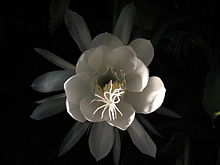Epiphyllum oxypetalum
| Epiphyllum oxypetalum | |
|---|---|
 |
|
| Flower of Epiphyllum oxypetalum | |
| Scientific classification | |
| Kingdom: | Plantae |
| (unranked): | Angiosperms |
| (unranked): | Eudicots |
| (unranked): | Core eudicots |
| Order: | Caryophyllales |
| Family: | Cactaceae |
| Genus: | Epiphyllum |
| Species: | E. oxypetalum |
| Binomial name | |
|
Epiphyllum oxypetalum (DC.) Haworth |
|
| Synonyms | |
|
|
Epiphyllum oxypetalum (Dutchman's pipe cactus or queen of the night) is a species of cactus and one of the most cultivated species in the genus. E. oxypetalum blooms rarely and only at night, and its flowers wilt before dawn. Though it is sometimes referred to as a nightblooming cereus, it is not closely related to any of the species in the tribe Cereeae, such as Selenicereus, that are more commonly known as nightblooming cereus. All Cereus species bloom at night and are terrestrial plants; all Epiphyllum species are usually epiphytic.
Epiphyllum oxypetalum is native to Southern Mexico and to extensive areas of South America. It is widely cultivated, escapes from cultivation in tropical areas, and has become naturalised in China.
Oxypetalum (Latin) = with acute petals
In India it is called Brahma Kamalam, named after the Hindu god of creation, Lord Brahma. It is believed that the wishes of people who pray to God while the flower is blooming will be fulfilled.
The Chinese chengyu (four character idiom) 曇花一現 (tan hua yi xian) use this flower (tan-hua; 曇花) to describe someone who has an impressive but very brief moment of glory, like a "flash in a pan," since a Epiphyllum oxypetalum plant might bloom only once a year over a few days. Therefore, someone described as "曇花一現" is generally understood to be a person who shows off or unexpectedly gains some achievement and is thought to be an exception or only lucky. The flower also has a rich history in Japan, where it is known as the (Gekka Bijin) or "Beauty under the Moon". In Sri Lanka it is called "Kadupul" (කඩුපුල්) which means the flower from heaven.
This species is closely related to E. thomasianum and E. pumilum, but quite distinct from them. In 1909, C. A. Purpus collected a slightly different type in St. Ana, Orizaba, Mexico. It has carmine red outer petals and the flowers have an unpleasant smell, rather than being fragrant. It was originally named Phyllocactus purpusii, but is now included within this species.
Epiphyllum oxypetalum is an easily cultivated, fast growing Epiphyllum. It flowers in late spring through late summer; large specimens can produce several crops of flowers in one season. This is the most commonly grown of the Epiphyllum species.
...
Wikipedia

